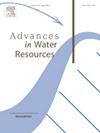Karhunen–Loève deep learning method for surrogate modeling and approximate Bayesian parameter estimation
IF 4.2
2区 环境科学与生态学
Q1 WATER RESOURCES
引用次数: 0
Abstract
We evaluate the performance of the Karhunen–Loève Deep Neural Network (KL-DNN) framework for surrogate modeling and approximate Bayesian parameter estimation in partial differential equation models. In the surrogate model, the Karhunen–Loève (KL) expansions are used for the dimensionality reduction of the number of unknown parameters and variables, and a deep neural network is employed to relate the reduced space of parameters to that of the state variables. The KL-DNN surrogate model is used to formulate a maximum-a-posteriori-like least-squares problem, which is randomized to draw samples of the posterior distribution of the parameters.
We test the proposed framework for a hypothetical unconfined aquifer via comparison with the forward MODFLOW and inverse PEST++ iterative ensemble smoother (IES) solutions as well as the state-of-the-art Fourier neural operator (FNO) and deep operator networks (DeepONets) operator learning surrogate models. Our results show that the KL-DNN surrogate model outperforms FNO and DeepONet for forward predictions. For solving inverse problems, the randomized algorithm provides the same or more accurate Bayesian predictions of the parameters than IES as evidenced by the higher log predictive probability of both the estimated parameter field and the forecast hydraulic head. The posterior mean obtained from the randomized algorithm is closer to the reference parameter field than that obtained with FNO as the maximum a posteriori estimate.
karhunen - lo深度学习方法的代理建模和近似贝叶斯参数估计
我们评估了karhunen - lo深度神经网络(KL-DNN)框架在偏微分方程模型中的代理建模和近似贝叶斯参数估计的性能。在代理模型中,使用karhunen - lo (KL)展开式对未知参数和变量进行降维,并使用深度神经网络将参数降维空间与状态变量的降维空间联系起来。KL-DNN代理模型用于制定一个最大后验样最小二乘问题,该问题随机抽取参数后验分布的样本。
本文章由计算机程序翻译,如有差异,请以英文原文为准。
求助全文
约1分钟内获得全文
求助全文
来源期刊

Advances in Water Resources
环境科学-水资源
CiteScore
9.40
自引率
6.40%
发文量
171
审稿时长
36 days
期刊介绍:
Advances in Water Resources provides a forum for the presentation of fundamental scientific advances in the understanding of water resources systems. The scope of Advances in Water Resources includes any combination of theoretical, computational, and experimental approaches used to advance fundamental understanding of surface or subsurface water resources systems or the interaction of these systems with the atmosphere, geosphere, biosphere, and human societies. Manuscripts involving case studies that do not attempt to reach broader conclusions, research on engineering design, applied hydraulics, or water quality and treatment, as well as applications of existing knowledge that do not advance fundamental understanding of hydrological processes, are not appropriate for Advances in Water Resources.
Examples of appropriate topical areas that will be considered include the following:
• Surface and subsurface hydrology
• Hydrometeorology
• Environmental fluid dynamics
• Ecohydrology and ecohydrodynamics
• Multiphase transport phenomena in porous media
• Fluid flow and species transport and reaction processes
 求助内容:
求助内容: 应助结果提醒方式:
应助结果提醒方式:


